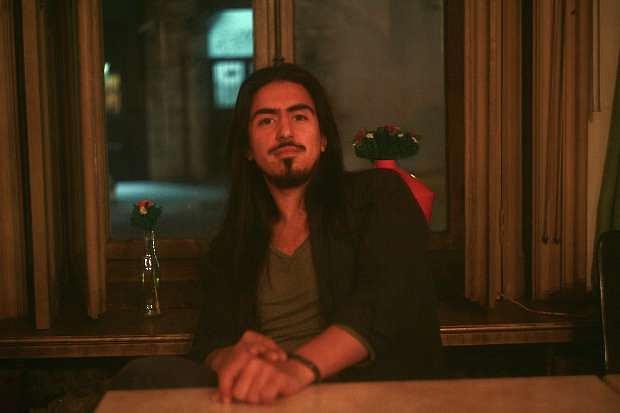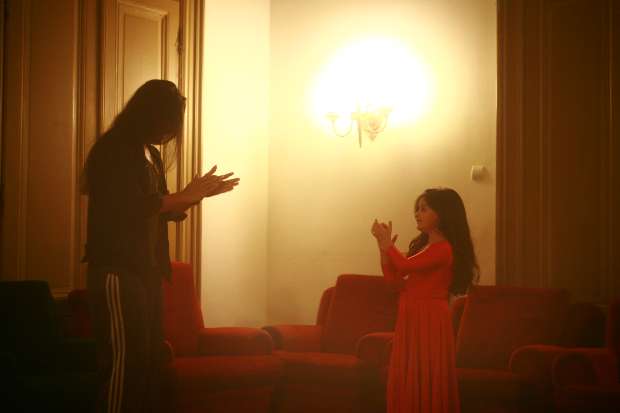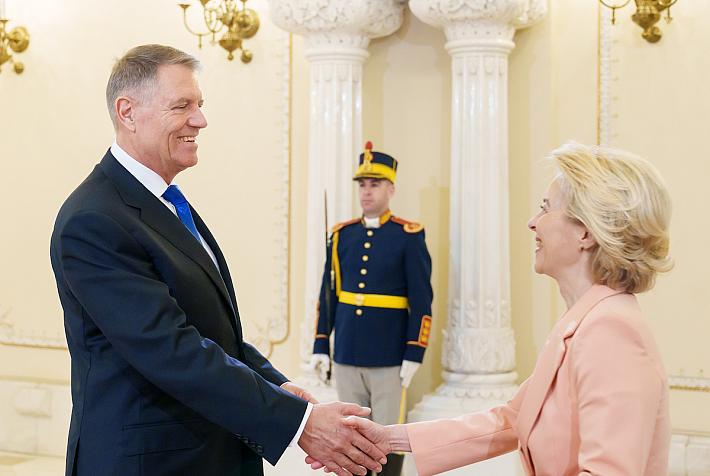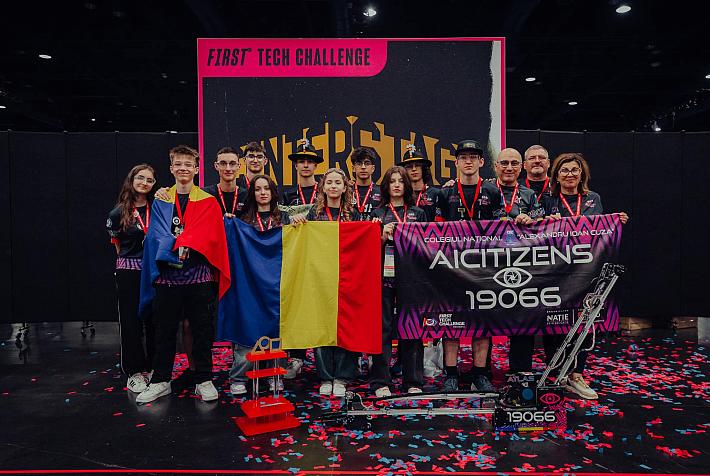Keeping the Flamenco rhythm with Lucas Molina

A Flamenco story starts in Buenos Aires and continues in Bucharest.
The silhouette of a tall man and that of a little girl are moving slowly around the room, at Green Hours, in Bucharest. Lucas Molina sets the rhythm by clapping and the girl, Maria, tries to follow him, un-dos-tres, un-dos-tres. Wearing a long red dress, on which she stamps from time to time, and Flamenco-tailored high heels, the seven-year old girl clumsily tries to learn the movements. She often complains that it's too difficult, but in certain moments you can feel her concentration and how she slowly gets into the rhythm. Then she's not anymore a charming little girl playing, but you can actually see the focus and beauty of a dancer. They start over and over again doing the same exercise. "Are you telling your teachers at school that you can't do something? I don't believe it," Lucas says jokingly.
But there was a beginning for Lucas Molina as well, now a Flamenco dancer and teacher in Bucharest. About ten years ago, he was walking in his neighbourhood in Buenos Aires, Villa Urquiza, a place with quiet streets and little fast-traffic, when he saw a flyer hung on a door. It was quite a windy day and the flyer was waving too obviously to ignore it. So he did what people do when something catches their attention. He stopped and took a look.
The flyer was showing a woman and a guitar and was informing about a Flamenco course, which took place every Tuesday and Thursday. Lucas was 17-year old old back then and knew almost nothing about it. He had just gone through a painful break-up, had enrolled at the University of Arts to study drawing and was looking for something to bring him on a different track. When he saw that ad he thought ‘why not’, so he took his guitar and went to the advertised studio, expecting to go to a music class. That’s what he thought Flamenco meant: guitar music.
He opened the door of the studio and saw inside a curvy woman with dark hair playing the guitar. Her name was Coca, she was in her late thirties and her imposing body posture was more than intimidating. She was a Flamenco dancer and every detail of her body was expressing it. “Hello, I came to learn guitar,” Lucas told her. “What guitar, can’t you see this is a dance studio?” Coca answered. “But I thought Flamenco is a guitar thing…,” he replied. “No, Flamenco is a dance.”
“She looked at me from top to bottom and I got very intimidated. You could do some dancing, she told me. And that’s how I started the Flamenco lessons,” Lucas tells me when we meet in Bucharest, beginning of April. I’ve arrived about one hour later than we planned, but he was expecting me there, sitting bolt upright, very calmly, sipping from a ginger soda. His long, dark hair and the imposing posture were those of a Flamenco dancer. We decided upon Green Hours, because Lucas, now 28, teaches there percussion and Flamenco lessons.
But years ago in Buenos Aires, he continued to go to Coca’s dance lessons for about three months until things took a different speed. His 18th birthday followed and his mom prepared a great party. She rented a salon and all the family and his friends were invited. In Argentina, when a boy turns 18, and a girl 15, the celebration has to be big.
It was June 16, the night of the party. The 70 guests already arrived, when his friends came, took him and locked him with a key in the bathroom. “You have to wait here,” they told him. “Come on, it’s my birthday, why are you keeping me here, what’s going on?”. They guys were all laughing and making fun. Finally they let him go and Lucas heard a Flamenco guitar. In the middle of the salon there was a flamenco band playing, two guitarists, a percussionist and Coca, his teacher, was dancing there. “I couldn’t do or say anything, I just set there and started crying. And she invited me to dance with her and I had been taking lessons for about three months only, so I knew nothing, but I went and danced, badly of course, but people were cheering,” Lucas told me. “Afterwards I stayed with the musicians at their table and we became friends that night.”
That’s how things really started for Lucas Molina and how he slowly shifted to music. He spent all his weekends with the band, following the musicians everywhere, just looking at them, paying attention in order to learn. “First thing, you need to be patient. You can’t start dancing right away.” In Argentina, the summer starts in December and by then he was part of the big family the musicians were forming and he was dancing in their shows. “The guys were about 30, 40 and there were a lot of them, violinists, percussionists, dancers. They were all gypsies, whose grandparents came from Spain, but they were all born in Argentina.”
“We were playing until 1, 2 in the night and after the Flamenco gigs ended we were going to the Turks, where there was Arabic music playing until 6 in the morning.” Lucas learned about belly dance and started playing the cajon, a box-shaped percussion instrument originally from Peru, and darbuka (the goblet drum), a percussion instrument used in the Middle East and North Africa. His percussion teacher was Sergio Montana, who was into arab rock. It was about mixing different types of music. Lucas discovered the fusion concept and immediately fell for it. “My first fusion was between Flamenco and Arabic, but meanwhile I tried mixing different types of music, even classical music with Flamenco.”
While Lucas recollects his early days as a dancer and musician in Buenos Aires, a blonde girl, in her late twenties, nears a bit reluctantly. “Hello, I am Natalia. I wrote you on Facebook yesterday, that I would like to join the Flamenco class. You told me I needed special shoes and the problem is that I haven’t brought any. I am also not sure I will like it. It is ok if it’s just a trial day? I don’t feel very prepared.” Lucas tells her that it’s ok to dance in socks or in her normal shoes for the first class, that it’s ok that to feel a bit insecure in the beginning and that the class will start in about one hour and a half.
“Flamenco is for me a way to be present. This is the most important thing in everything. If you don’t feel like you’re part of this specific moment, it’s hard to do things properly,” Lucas explains me. “Through Flamenco and percussion I try to learn people to be present. And actually the topic of the class itself it’s not that important. It could have been a cooking class. It’s vital to do something where both your mind and your soul are focused. My mom wanted me to be a doctor, or a lawyer and I told her, no, that’s not my life, I don’t want to do something where I can’t be 100% present.”
When he was 19, Lucas went living on his own. He needed to take a distance from his family and to search for a balance he felt he was lacking. He met a Romanian woman, who was older than him and moved in together. By then he was fully taking part in adult life. In the morning he was working as a tour manager for a big events company which brought foreign artists to Argentina. After that he was teaching Flamenco or percussion and in the evenings he was dancing or playing in different places. By 22 he had a life fully booked. “I had a rented house with my girlfriend, life was very clear. Everything was programmed, like a clock.”
“Things changed completely when I did my first trip to Europe. My story turned upside down.” He was playing with a belly dance group and took a vacation to go touring to Europe. “When I got off the plane in Madrid and I set my foot on the ground, after a 14-hours trip, I felt that the world is very big. I became aware in a very deep way that if anything happens to me here, nobody knows me. I can do anything. My past doesn’t matter anymore. It’s only here and now.”
“I had to meet the rest of the band in Italy and while I was waiting in the airport in Madrid for my connection flight for six hours, I was just looking at people and no one was looking at me. I felt very small and I felt a great humbleness. It was both scary and great.”
After the tour in Italy and Spain ended, he had a vacation week left so he decided to come to Romania to meet the parents of his girlfriend. Some friends also went to the seaside, in Costinesti, so he joined them there. In a few days he got a job in Costinesti, playing in a club there. It could have been the eyeopener he had in Madrid, or some other reason, but he decided to stay in Romania. He left a clear, flawless life in Argentina for something new and uncertain.
“Whether I dance or I play, or I teach Flamenco or percussion, it’s all about joy. People need joy and that’s where music comes in. One has to rediscover joy.”
By Diana Mesesan, features writer, diana@romania-insider.com
(photos by Diana Mesesan)
















